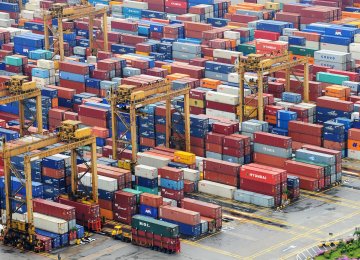Possible protectionism in advanced economies should not deter export-oriented growth in South Asia, a region that could even benefit from the backlash against globalization, a new World Bank report said Sunday.
The report also confirms that South Asia remains the fastest-growing region in the world, gradually widening its lead relative to East Asia. Regional GDP growth is expected to rise from 6.7% in 2016 to 6.8% in 2017, and 7.1% in 2018, Worldbank.org reported.
The just released edition of the twice-a-year South Asia Economic Focus explores whether South Asian countries should worry about mounting protectionist pressures. This report, Globalization Backlash, claims that global integration has been good for economic development and poverty reduction, but finds that the region would be resilient to higher trade barriers in advanced economies. It would even stand to gain if selective protectionism resulted in trade diversion away from established suppliers. South Asian economies also stand to gain from the observed recovery in advanced economies, which are their largest export markets.
"Simulations on the impact of hypothetical new trade barriers show that South Asia is not only resilient to a potential rise in protectionism but could possibly even gain from it in some circumstances,” said Annette Dixon, the World Bank South Asia Region vice president. “Advanced economies are recovering and could see faster growth that will likely increase demand for South Asian products. The region should seize this opportunity to diversify its exports and enhance its supply response. This could create a substantial number of jobs for new entrants to the labor force.”
Growth Remains Strong
Given its weight in the region, India sets the pace for South Asia as a whole. Its GDP growth is expected to accelerate to 7.2% in 2018, after expanding by a slightly lower than expected 6.8% in 2016, with a temporary disruption from the withdrawal of large denomination bank notes.
Based on tangible improvements in security, Pakistan continues its upward trend and growth is expected to accelerate to over 5% this year. Nepal and Maldives are bouncing back from economic shocks.
Analysis of different hypothetical trade scenarios finds that South Asia stands to benefit from the stall of large regional trade agreements such as the Trans-Pacific Partnership. It would also gain in the hypothetical scenario of greater protectionism against major exporting countries such as China and Mexico. The research finds that South Asian growth is highly responsive to higher growth in advanced economies, which could offset potential losses from changes in trade policy.
Afghanistan’s economic recovery has been slow, as insecurity continues to curtail private investment and consumer demand. Growth is projected to accelerate slightly from 1.2% in 2016 to 2.4% in 2017. However, with population growth of nearly 3%, such level of economic growth implies a decline in per capita income.
The economy in Bangladesh has weathered global uncertainties well aided by strengthening investment and a recovery of exports. Growth will be sustained at 6.8% in 2017, coming slightly down from 7.1% in 2016 and with a decelerating information rate and a budget deficit that has narrowed. Infrastructure gaps and inadequate energy supply, combined with the high cost of doing business, remain the main obstacles to the realization of Bangladesh’s growth potential.
Economic activity in Bhutan has kept growth strong with the economy expected to grow at 6.8% once again in 2017. Hydropower projects, supportive fiscal and monetary policy coupled with low inflation, a stable exchange rate and accumulating international reserves have contributed to growth and poverty reduction.
In Maldives, GDP growth rebounded to an estimated 4.1% in 2016 and is expected to grow at 4.5% in 2017 through substantial investments and construction activity. It is important that Maldives preserves its tax base and efficient tax system, as it prepares to develop Special Economic Zones offering tax concessions.
Nepal is seeing a broad economic recovery after a number of setbacks including the earthquakes of 2015. Its economic activity is recovering with growth expected to rebound to 6% in 2017 on the back of increased agriculture output, increased availability of electricity, and greater investment as the earthquake reconstruction gathers speed, compared 0.6% growth in 2016.
Sri Lanka’s economic growth is projected to grow at 4.7% in 2017, up from 4.4% 2016 which reflects significant contributions from construction, trade, and financial services as well the as negative impacts of floods and droughts.






Add new comment
Read our comment policy before posting your viewpoints